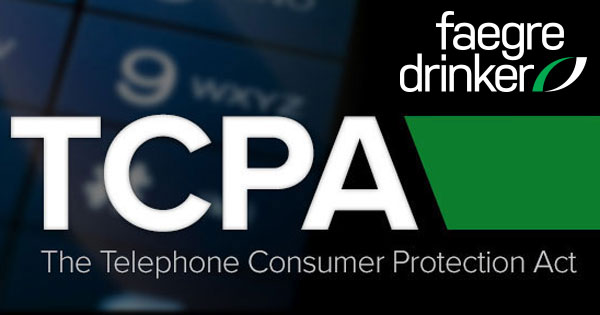In Zarichny v. Complete Payment Recovery Servs., Civ. No. 14-3197, 2015 U.S. Dist. LEXIS 6556 (Jan. 21, 2015), Plaintiff Sandra Zarichny attempted to bring a class action on behalf of two classes against defendants Fidelity National Information Services (“FIS”) and Complete Payment Recovery Services (“CPRS”). Id. at *1-2. Zarichny alleges that the defendants called her eleven times because they incorrectly believed that she owed a debt based on her alleged failure to return textbooks that she rented. Id. at 7-8. In her complaint, Zarichny alleged that the Defendants deliberately harassed her by calling at inconvenient times. Id. at 9. Zarichny alleged that both corporations violated the TCPA and the Fair Debt Collections Practices Act (the “FDCPA”).
Fidelity and CPRS brought a motion to dismiss Zarichny’s complaint and a motion to strike her class allegations, which the court granted in part and denied in part.
First, the Court dismissed FIS after finding that Zarichny failed to allege that FIS made any phone calls and after finding that the circumstances did not warrant holding it liable as a parent corporation. Id. at *15-16. The Court denied CPRS’s motion to dismiss Zarichny’s TCPA claim after finding that CPRS had the burden of proving that Zarichny consented to receiving the calls at issue. Id. at *18. The Court allowed Zarichny to proceed on one FDCPA claim after finding that she had pled sufficient facts to show that CPRS may have violated the written notice provision of the FDCPA. Id. at *26 .
The Court then turned to Defendants’ motion to strike Zarichny’s class allegations. Id. at *26-27. Zarichny sought to bring an action on behalf of two classes; those “‘who received one or more telephone calls from [d]efendants to whom [d]efendants did not send a written notice pursuant to 15 U.S.C. § 1692g,’” and those “‘who received one or more telephone calls from [d]efendants on the individual’s cellular telephone that was initiated using an automatic telephone dialing system.’” Id. at *27. Defendants’ argued that these were “fail-safe” classes because qualification would be based on whether an individual had a valid claim. Id. Zarichny in turn argued that any ruling on class certification would be premature because she had not moved for class certification and that the class definitions could be revised through discovery. Id. at *28.
The Court struck the class allegations due the existence of a fail-safe class. Id. at *29 (“Because plaintiff’s class definitions create impermissible fail-safe classes, we need not consider defendants’ second ground for striking her class allegations…”). While Judge Dalzell acknowledged the existence of a circuit split regarding the permissibility of fail-safe classes, he noted the initial need to consider two criteria before looking to the four requirements of class certification. Id. at *30 (“[O]ur Court of Appeals obliges us to establish two preliminary criteria. We must (1) clearly define the perimeter of the class and the claims to be given class treatment pursuant to Rule 23(c)(1)(B), and (2) determine whether the class is objectively ascertainable.”).
Next, Judge Dalzell then looked to the Third Circuit’s holding in Marcus v. BMW of North America LLC, 687 F.3d 583 (3d Cir. 2012), to determine whether Zarichny’s proposed class was ascertainable. After noting the factors the Third Circuit considered in Marcus, Judge Dalzell noted that “[i]f such ascertainability is not met based on objective criteria the class definition must fail.” Id. at 31-32. Here, Judge Dalzell recognized that the classes were not ascertainable:
A similar problem faces us here. As one commentator explained, “[F]ail-safe classes [are] one category of classes failing to satisfy the ascertainability requirement.” Both classes Zarichny defined are fail-safe classes….Since we are at the outset of this litigation, there is no way to provide notice to that putative class without the sort of extensive fact finding that class actions should avoid. Similarly, at the conclusion the litigation should CPRS prevail against Zarichny, any other putative class recipient would be free to litigate the same claim against CPRS.
Id. at *32-33.
The ultimate problem with a fail-safe class is that its members of a fail-safe class would not be bound by an adverse judgment. Two outcomes exist. First, their claims could be proven on the merits (in which case they are members of the class and enjoy the benefits of the judgment) or they could be disproven (in which case they are not members of the class and are not bound by the judgment). In either case, fail-safe classes are a no-win proposition for defendants that violate the 1966 amendments to Rule 23, which rejected the practice of “one-way intervention” and required that judgments be binding “[w]hether or not favorable to the class.” Fed. R. Civ. P. 23(c)(3); Fed. R. Civ. P. 23(c)(3) 1966 Advisory Committee Notes, Subdivision (c)(3). Judge Dalzell’s opinion recognizes the flawed and unjust results that could emerge from fail-safe classes.

